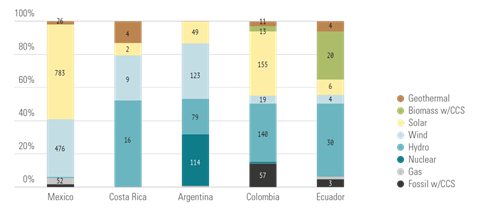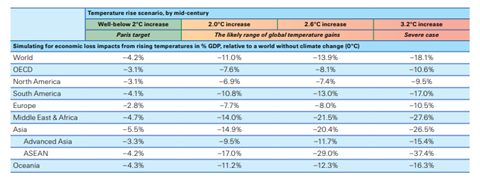By Hamish Stewart (@hamishms), Senior Associate, Climate, PRI

In advance of an upcoming Investor Agenda webinar on net zero target setting in Latin America, this blog highlights a number of key themes in the continent’s energy transition and the importance of investor climate action plans to enable systematic progress. Interested investors can register for the live Spanish language discussion on 22 September.
This year, investors in Latin America have a unique window of opportunity to join the global Race to Zero. Ten countries – Chile, Colombia, Costa Rica, Dominican Republic, Ecuador, Guatemala, Haiti, Honduras, Paraguay and Peru – have already committed to a collective regional objective of 70% of renewable energy by 2030, and more countries are signing up to bold net zero commitments. Large players including Brazil and Mexico still have catching up to do and investor leadership can help raise this ambition. As countries in the region prepare to take action ahead of the COP26, Latin American investors are also stepping up to commit to align their investment practices with net zero targets. As part of the kick-off for NYC Climate Week, the PRI is thrilled to be hosting an Investor Agenda webinar on the Race to Zero in Latin America. The 22 September event will bring together investors from across the continent to assess opportunities for regional leadership on net zero target setting and associated transition to net zero emissions in the real economy.
Responding to climate adaptation & the COVID-19 challenge
The zero-carbon energy and infrastructure push in Latin America continues to benefit from the four “D” trends of digitisation, decentralisation, decarbonisation, and the democratisation of ownership in energy. Regional investors must also adapt their approach across the continent to reflect this rapid technological progress, and the high cost of complacency as extreme weather events impair asset values and encourage more volatile politics. The pandemic has accelerated the trend towards digitalisation of energy and economic systems with unprecedented growth in demand for data centers, high speed fibre networks and cellular transmission towers alongside digital health applications.
COVID-19 has strained conventional infrastructure and dampened government capacity to finance a rapid clean energy buildout, but the continent is preparing for a large infrastructure push. Investors have a key role to play in this process. Mexico is planning major additional infrastructure investments, including offshore wind, and Brazil’s economy is recovering from a sharp contraction last year. Beyond these two regional giants, Chile’s $1.4 billion Cerro Dominador solar power project, a push into geothermal power generation in a number of countries, and the launch of an offshore wind industry in the Gulf of Mexico all demonstrate the potential for rapid change.
Each country’s path to net zero will be different, but it is clear that the economy-wide shift to electrification of building heating and cooling, vehicles and industry combined with decarbonisation of electricity generation will transform the continent of 660 million people. Investors and the companies they invest in will both need to have climate action plans in place to ensure an orderly transition.
Investor climate action plans required for systematic action
As in other regions, setting and then operationalising climate targets in Latin America is challenging. To help investors begin to set net zero targets and then act on them, the Investor Agenda has developed the Investor Climate Action Plans (ICAPs) Expectations Ladder. The ladder is inclusive and meant for all investors wherever they are on their climate change journey. It provides a summary of actions identified over four tiers, enabling all investors to benchmark progress from the very beginning. The four tiers are designed for use by investors who may be beginning to consider climate aligned strategies (Tier 4) and by those who are already setting the global best practice standards for portfolio and real economy decarbonisation in line with Paris Agreement pathways (Tier 1). The ICAPs Expectations Ladder also defines opportunities for investor action across four interlocking areas - investment strategy, corporate engagement, policy advocacy and investor disclosure, and also examines governance. In time for COP26, investors in Latin America will be able to access a Spanish language version of the documents on the Investor Agenda home page.

Regional investors can respond to climate risk impacts
The PRI’s Iniciativa climática inversionistas LatAm (ICIL) responds to the need to rapidly scale up investor readiness for climate risk and adaption. The recent IPCC report made it clear that the global temperature rise will negatively impact GDP in all regions by mid-century. According to research from insurer SwissRe, the current climate heating trajectory, even assuming action with respect to climate change mitigation pledges, points to global warming of 2-2.6°C by mid-century. The loss in global economic value in this scenario could be up to 10% higher if the Paris Agreement target of well below 2°C rise in temperatures is not reached. In a severe scenario of a 3.2°C temperature rise, the global GDP loss could be as much as 14% higher than that under the Paris targets. This is what investors in Latin America and other regions must begin considering in designing climate action plans that balance climate adaptation with rapid emissions reductions and investment in new energy systems across all countries. The downside risk of inaction is enormous.

Net zero job creation push requires leadership
Climate change investing is not all about downside risk management. Latin America already has lower per capita emissions relative to most other regions and the shift to clean energy could unlock significant economic opportunities. The ILO’s recent report on jobs in a net-zero emissions future, notes that Latin America’s transition to net-zero emissions has the potential to create 19 million net jobs by 2030.
In the transition to a net-zero carbon economy, 7.5 million jobs are destroyed in fossil fuel electricity, fossil fuel extraction, and animal-based food production. However, these lost jobs are more than compensated by new employment opportunities, as 22.5 million jobs are created in agriculture and plant-based food production, renewable electricity, forestry, construction, and manufacturing.
Source: ILO
How investors incorporate the incredible range of climate-related investment opportunities while also assessing and responding to climate risk will define the decade ahead. With Latin American investors beginning to turn climate ambition into action plans, join us with questions for our expert speakers from across the region. Register here.
This blog is written by PRI staff members and guest contributors. Our goal is to contribute to the broader debate around topical issues and to help showcase some of our research and other work that we undertake in support of our signatories.Please note that although you can expect to find some posts here that broadly accord with the PRI’s official views, the blog authors write in their individual capacity and there is no “house view”. Nor do the views and opinions expressed on this blog constitute financial or other professional advice.If you have any questions, please contact us at [email protected].












